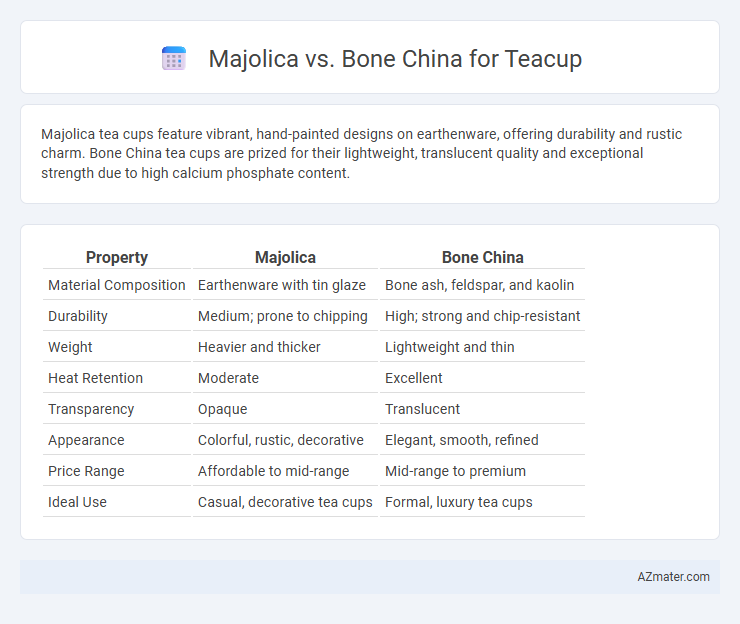Majolica tea cups feature vibrant, hand-painted designs on earthenware, offering durability and rustic charm. Bone China tea cups are prized for their lightweight, translucent quality and exceptional strength due to high calcium phosphate content.
Table of Comparison
| Property | Majolica | Bone China |
|---|---|---|
| Material Composition | Earthenware with tin glaze | Bone ash, feldspar, and kaolin |
| Durability | Medium; prone to chipping | High; strong and chip-resistant |
| Weight | Heavier and thicker | Lightweight and thin |
| Heat Retention | Moderate | Excellent |
| Transparency | Opaque | Translucent |
| Appearance | Colorful, rustic, decorative | Elegant, smooth, refined |
| Price Range | Affordable to mid-range | Mid-range to premium |
| Ideal Use | Casual, decorative tea cups | Formal, luxury tea cups |
Introduction to Majolica and Bone China
Majolica tea cups, crafted from earthenware clay and coated with a vibrant tin-glaze, offer a richly textured and colorful finish that is both decorative and durable. Bone China, made from a refined mixture of bone ash, kaolin, and feldspar, is renowned for its translucency, lightweight feel, and exceptional strength, making it a premium choice for delicate tea cups. Both materials deliver unique aesthetic and tactile experiences, with Majolica emphasizing artistry and bold patterns, while Bone China highlights elegance and refined craftsmanship.
Historical Origins and Evolution
Majolica originated in the Renaissance period, characterized by its vibrant tin-glazed earthenware developed in Italy, while Bone China was first produced in 18th-century England, renowned for its translucent quality and durability due to the inclusion of bone ash. Majolica's evolution reflects intricate hand-painted designs and robust ceramic composition, often used for decorative tableware, contrasting with Bone China's refinement in tea cup production emphasizing delicate, lightweight elegance. Historical usage shows Majolica favored in Mediterranean settings with bold artistic expression, whereas Bone China became synonymous with British tea culture and global premium porcelain markets.
Material Composition and Manufacturing
Majolica tea cups are crafted from earthenware clay, coated with a colorful lead-based glaze, and fired at lower temperatures, resulting in a porous, rustic, and vibrant finish. Bone china tea cups incorporate bone ash, feldspar, and kaolin, offering a lighter, more translucent material that is fired at higher temperatures for enhanced strength and a smooth, delicate appearance. The manufacturing of bone china involves precise firing and layering techniques for durability and elegance, whereas majolica emphasizes artisanal glazing methods to achieve its characteristic ornate patterns.
Visual Appeal and Aesthetic Differences
Majolica tea cups feature vibrant, hand-painted glazes with intricate floral or nature-inspired motifs that create a rich, textured surface appealing to collectors and traditionalists. Bone china exhibits a translucent, smooth finish and delicate, often minimalist designs, imparting an elegant and refined aesthetic favored in formal tea settings. The glossy, colorful majolica contrasts with the pristine, understated sophistication of bone china, highlighting a distinct visual and tactile experience for tea enthusiasts.
Durability and Strength Comparison
Majolica tea cups are known for their thick, robust ceramic composition, providing exceptional durability and resistance to chipping under daily use. Bone china tea cups, while more delicate in appearance, offer surprising strength due to their high bone ash content, making them lightweight yet less prone to cracking compared to standard porcelain. Majolica excels in resilience for casual settings, whereas bone china balances elegance with impressive tensile strength ideal for careful handling.
Heat Retention and Tea Experience
Majolica tea cups, renowned for their dense, glazed earthenware, offer moderate heat retention and a vibrant aesthetic that enhances the tea-drinking experience with a rustic charm. Bone china, composed of bone ash mixed with porcelain clay, excels in heat retention, keeping tea warmer for extended periods while providing a delicate, lightweight feel ideal for refining the sensory enjoyment of tea flavors. Choosing between Majolica and bone china tea cups largely depends on the balance of heat retention needs and the desired tactile and visual tea experience.
Weight and Handling Comfort
Majolica tea cups are generally heavier due to their thick, porous ceramic composition, offering a sturdy feel that some users find comforting, though it may cause hand fatigue during extended use. Bone china tea cups are notably lighter and thinner, providing superior handling comfort with a delicate, smooth texture that enhances the overall tea-drinking experience. The lightweight nature of bone china reduces wrist strain, making it an ideal choice for those prioritizing ease of use and elegant aesthetics in their tea service.
Maintenance and Care Requirements
Majolica tea cups require careful handling due to their porous nature and brightly colored glazes, which can chip or stain if exposed to harsh detergents or abrasive scrubbers. Bone china offers greater durability and resistance to stains, making it easier to maintain with gentle hand washing and mild dish soap. For both materials, avoiding extreme temperature changes and dishwasher use extends their lifespan and preserves their delicate finishes.
Popular Brands and Market Availability
Majolica tea cups, known for their vibrant, hand-painted designs, are widely available from popular brands like Bordallo Pinheiro and Villeroy & Boch, offering an artisanal touch with broad market presence. In contrast, bone china tea cups, favored for their delicate translucency and strength, dominate the premium segment with renowned brands such as Royal Doulton, Wedgwood, and Churchill, ensuring extensive availability in high-end retail outlets. Both types enjoy strong market demand, with Majolica appealing to collectors and rustic decor enthusiasts, while bone china remains the preferred choice for formal tea settings and luxury consumers.
Choosing the Best Option for Your Tea Ritual
Majolica tea cups offer vibrant, hand-painted designs with durable earthenware ideal for casual, artistic tea rituals, while bone china provides a refined, translucent finish prized for elegance and heat retention in formal settings. Selecting the best option depends on your preference for durability and bold aesthetics versus delicate craftsmanship and temperature control. Consider Majolica for rustic charm and resilience or bone china for classic sophistication and a refined tea experience.

Infographic: Majolica vs Bone China for Tea Cup
 azmater.com
azmater.com